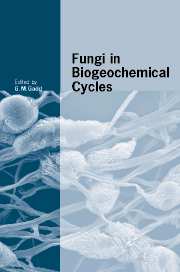Book contents
- Frontmatter
- Contents
- List of Contributors
- Preface
- 1 Geomicrobiology: relative roles of bacteria and fungi as geomicrobial agents
- 2 Integrated nutrient cycles in boreal forest ecosystems – the role of mycorrhizal fungi
- 3 Fungal roles in transport processes in soils
- 4 Water dynamics of mycorrhizas in arid soils
- 5 Integrating ectomycorrhizal fungi into quantitative frameworks of forest carbon and nitrogen cycling
- 6 Role of arbuscular mycorrhizal fungi in carbon and nutrient cycling in grassland
- 7 The role of wood decay fungi in the carbon and nitrogen dynamics of the forest floor
- 8 Relative roles of bacteria and fungi in polycyclic aromatic hydrocarbon biodegradation and bioremediation of contaminated soils
- 9 Biodegradation and biodeterioration of man-made polymeric materials
- 10 Fungal dissolution and transformation of minerals: significance for nutrient and metal mobility
- 11 Fungal activities in subaerial rock-inhabiting microbial communities
- 12 The oxalate–carbonate pathway in soil carbon storage: the role of fungi and oxalotrophic bacteria
- 13 Mineral tunnelling by fungi
- 14 Mineral dissolution by ectomycorrhizal fungi
- 15 Lichen biogeochemistry
- 16 Fungi in subterranean environments
- 17 The role of fungi in carbon and nitrogen cycles in freshwater ecosystems
- 18 Biogeochemical roles of fungi in marine and estuarine habitats
- Index
- References
10 - Fungal dissolution and transformation of minerals: significance for nutrient and metal mobility
Published online by Cambridge University Press: 10 December 2009
- Frontmatter
- Contents
- List of Contributors
- Preface
- 1 Geomicrobiology: relative roles of bacteria and fungi as geomicrobial agents
- 2 Integrated nutrient cycles in boreal forest ecosystems – the role of mycorrhizal fungi
- 3 Fungal roles in transport processes in soils
- 4 Water dynamics of mycorrhizas in arid soils
- 5 Integrating ectomycorrhizal fungi into quantitative frameworks of forest carbon and nitrogen cycling
- 6 Role of arbuscular mycorrhizal fungi in carbon and nutrient cycling in grassland
- 7 The role of wood decay fungi in the carbon and nitrogen dynamics of the forest floor
- 8 Relative roles of bacteria and fungi in polycyclic aromatic hydrocarbon biodegradation and bioremediation of contaminated soils
- 9 Biodegradation and biodeterioration of man-made polymeric materials
- 10 Fungal dissolution and transformation of minerals: significance for nutrient and metal mobility
- 11 Fungal activities in subaerial rock-inhabiting microbial communities
- 12 The oxalate–carbonate pathway in soil carbon storage: the role of fungi and oxalotrophic bacteria
- 13 Mineral tunnelling by fungi
- 14 Mineral dissolution by ectomycorrhizal fungi
- 15 Lichen biogeochemistry
- 16 Fungi in subterranean environments
- 17 The role of fungi in carbon and nitrogen cycles in freshwater ecosystems
- 18 Biogeochemical roles of fungi in marine and estuarine habitats
- Index
- References
Summary
Introduction
Fungi are chemoheterotrophic organisms, ubiquitous in subaerial and subsoil environments, and important as decomposers, animal and plant symbionts and pathogens, and spoilage organisms of natural and man-made materials (Gadd, 1993, 1999; Burford et al., 2003a). A fungal role in biogeochemical cycling of the elements (e.g. C, N, P, S, metals) is obvious and interlinked with the ability to adopt a variety of growth, metabolic and morphological strategies, their adaptive capabilities to environmental extremes and their symbiotic associations with animals, plants, algae and cyanobacteria (Burford et al., 2003a; Braissant et al., 2004; Gadd, 2004). Fungal polymorphism and reproduction by spores underpin successful colonization of different environments. Most fungi exhibit a filamentous growth habit, which provides an ability for adoption of either explorative or exploitative growth strategies, and the formation of linear organs of aggregated hyphae for protected fungal translocation (see Fomina et al., 2005b). Some fungi are polymorphic, occurring as both filamentous mycelium and unicellular yeasts or yeast-like cells, e.g. black meristematic or microcolonial fungi colonizing rocks (Sterflinger, 2000; Gorbushina et al., 2002, 2003). Fungi can also grow inside their own parental hyphae utilizing dead parts of the colony under the protection of parental cell walls (Gorbushina et al., 2003). The ability of fungi to translocate nutrients through the mycelial network is another important feature for exploring heterogeneous environments (Jacobs et al., 2002, 2004; Lindahl & Olsson, 2004).
The earliest fossil record of fungi in terrestrial ecosystems occurred during the Ordovician period (480 to 460 MYBP) (Heckman et al., 2001).
- Type
- Chapter
- Information
- Fungi in Biogeochemical Cycles , pp. 236 - 266Publisher: Cambridge University PressPrint publication year: 2006
References
- 22
- Cited by



